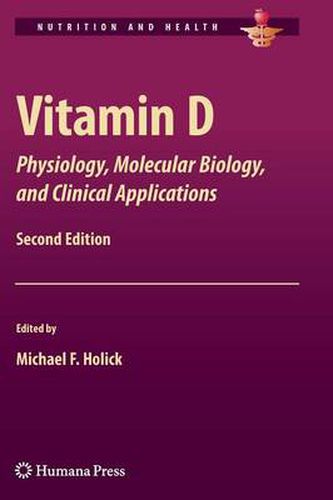Readings Newsletter
Become a Readings Member to make your shopping experience even easier.
Sign in or sign up for free!
You’re not far away from qualifying for FREE standard shipping within Australia
You’ve qualified for FREE standard shipping within Australia
The cart is loading…






This title is printed to order. This book may have been self-published. If so, we cannot guarantee the quality of the content. In the main most books will have gone through the editing process however some may not. We therefore suggest that you be aware of this before ordering this book. If in doubt check either the author or publisher’s details as we are unable to accept any returns unless they are faulty. Please contact us if you have any questions.
In Vitamin D: Physiology, Molecular Biology, and Clinical Applications, Second Edition, leading researchers provide a comprehensive, highly readable overview of the biological functions and clinical applications of vitamin D and its metabolites. Topics range from the most recent recommendations for vitamin D intake to new approaches for the treatment and prevention of vitamin D deficiency and the development of active vitamin D drugs to treat psoriasis and cancer. The book demonstrates the significant role that vitamin D has in maintaining good bone health and the prevention of osteoporosis, an important health problem for adults over the age of fifty. In addition, it authoritatively reviews the relationship between sunlight exposure, vitamin D, and increased risk of colon and breast cancer; how vitamin D is made in the skin; and the sequence of events that leads to its activation by the kidney. Also examined are the biological functions of 1,25-dihydrovitamin D3 on the intestine and bone, as well as other tissues, such as skin, the immune system, prostate, and breast, and vitamin D’s molecular mechanism of action on the cell membrane and nucleus.
The first edition of Vitamin D: Physiology, Molecular Biology and Clinical Applications was the benchmark in the field when published in 1999. This new and expanded volume continues to include extensive, in-depth chapters covering the most important aspects of the complex interactions between vitamin D and other dietary components, the ongoing debate concerning the best indicator of optimal vitamin D status and its nutrient requirements, and the impact of less than optimal status on disease risk. Vitamin D: Physiology, Molecular Biology, and Clinical Applications, Second Edition is designed and organized not only to be an up-to-date review on the subject, but also to provide medical students, graduate students, health care professionals and even the lay public with a reference source for the most up-to-date information about the vitamin D deficiency pandemic and its clinical implications for health and disease.
$9.00 standard shipping within Australia
FREE standard shipping within Australia for orders over $100.00
Express & International shipping calculated at checkout
This title is printed to order. This book may have been self-published. If so, we cannot guarantee the quality of the content. In the main most books will have gone through the editing process however some may not. We therefore suggest that you be aware of this before ordering this book. If in doubt check either the author or publisher’s details as we are unable to accept any returns unless they are faulty. Please contact us if you have any questions.
In Vitamin D: Physiology, Molecular Biology, and Clinical Applications, Second Edition, leading researchers provide a comprehensive, highly readable overview of the biological functions and clinical applications of vitamin D and its metabolites. Topics range from the most recent recommendations for vitamin D intake to new approaches for the treatment and prevention of vitamin D deficiency and the development of active vitamin D drugs to treat psoriasis and cancer. The book demonstrates the significant role that vitamin D has in maintaining good bone health and the prevention of osteoporosis, an important health problem for adults over the age of fifty. In addition, it authoritatively reviews the relationship between sunlight exposure, vitamin D, and increased risk of colon and breast cancer; how vitamin D is made in the skin; and the sequence of events that leads to its activation by the kidney. Also examined are the biological functions of 1,25-dihydrovitamin D3 on the intestine and bone, as well as other tissues, such as skin, the immune system, prostate, and breast, and vitamin D’s molecular mechanism of action on the cell membrane and nucleus.
The first edition of Vitamin D: Physiology, Molecular Biology and Clinical Applications was the benchmark in the field when published in 1999. This new and expanded volume continues to include extensive, in-depth chapters covering the most important aspects of the complex interactions between vitamin D and other dietary components, the ongoing debate concerning the best indicator of optimal vitamin D status and its nutrient requirements, and the impact of less than optimal status on disease risk. Vitamin D: Physiology, Molecular Biology, and Clinical Applications, Second Edition is designed and organized not only to be an up-to-date review on the subject, but also to provide medical students, graduate students, health care professionals and even the lay public with a reference source for the most up-to-date information about the vitamin D deficiency pandemic and its clinical implications for health and disease.